
Jersey Dolmens
Encyclopedia

Neolithic
The Neolithic Age, Era, or Period, or New Stone Age, was a period in the development of human technology, beginning about 9500 BC in some parts of the Middle East, and later in other parts of the world. It is traditionally considered as the last part of the Stone Age...
sites, including dolmen
Dolmen
A dolmen—also known as a portal tomb, portal grave, dolmain , cromlech , anta , Hünengrab/Hünenbett , Adamra , Ispun , Hunebed , dös , goindol or quoit—is a type of single-chamber megalithic tomb, usually consisting of...
s, in Jersey
Jersey
Jersey, officially the Bailiwick of Jersey is a British Crown Dependency off the coast of Normandy, France. As well as the island of Jersey itself, the bailiwick includes two groups of small islands that are no longer permanently inhabited, the Minquiers and Écréhous, and the Pierres de Lecq and...
. They range over a wide period, from around 4800 BC to 2250 BC, these dates covering the periods roughly designated as Neolithic, or “new stone age”, to Chalcolithic, or “copper age”.
Before that, La Cotte de St Brelade
La Cotte de St Brelade
La Cotte de St Brelade is a Paleolithic site of early habitation in St Brelade, Jersey. Cotte means "cave" in Jèrriais; the cave is also known as Lé Creux ès Fées....
has evidence of habitation both by our near cousins, the Neanderthal
Neanderthal
The Neanderthal is an extinct member of the Homo genus known from Pleistocene specimens found in Europe and parts of western and central Asia...
s, and early man. These come from the Paleolithic
Paleolithic
The Paleolithic Age, Era or Period, is a prehistoric period of human history distinguished by the development of the most primitive stone tools discovered , and covers roughly 99% of human technological prehistory...
or “old stone age”, and belong to the period of the hunter-gatherer, where the tribe would forage in pursuit of food; in the case of La Cotte, as we know from remains, woolly mammoth
Woolly mammoth
The woolly mammoth , also called the tundra mammoth, is a species of mammoth. This animal is known from bones and frozen carcasses from northern North America and northern Eurasia with the best preserved carcasses in Siberia...
was part of the diet.
History of dolmens in Jersey
By the time the dolmens came to be built, people were settled in Jersey, although it was still at that time connected by a land bridgeLand bridge
A land bridge, in biogeography, is an isthmus or wider land connection between otherwise separate areas, over which animals and plants are able to cross and colonise new lands...
to the continent of Europe (until around 6800 BC). The new stone age differs from the old in that stone tools were still used – axes, daggers etc – but the community was now settled and farmed the land; they did not hunt and follow prey.
Of their habitations, no trace remains; it is likely from the evidence found elsewhere that they had fairly basic wooden huts, sealed with mud and clay, which have been lost. Only the dolmens and menhir
Menhir
A menhir is a large upright standing stone. Menhirs may be found singly as monoliths, or as part of a group of similar stones. Their size can vary considerably; but their shape is generally uneven and squared, often tapering towards the top...
s remain.
The Neolithic sites such as dolmens, passage grave
Passage grave
thumb|250px|right|A simple passage tomb in [[Carrowmore]] near [[Sligo]] in IrelandA passage grave or passage tomb consists of a narrow passage made of large stones and one or multiple burial chambers covered in earth or stone. Megaliths are usually used in the construction of passage tombs, which...
s and the like used to be considered to be primarily tombs of chieftains.
Possibly drawing from the Egyptian model, a tribe was imagined as labouring away to build a burial site of stone for a mighty chieftain, much as the workers in Egypt had done for the pharaohs. Beliefs of ancient Egypt have survived in written form, and it seems clear that the embalmed body of the king was entombed underneath or within the pyramid to protect it and allow his transformation and ascension to the afterlife, and a place among the gods. A new pharaoh would mean a new tomb, a new pyramid, often built in fairly close proximity to others.
But the Neolithic sites do not seem to function like that. They are scattered. There is no easy way of seeing that someone was special, singled out. Bodies were often defleshed (left so that the flesh rotted away) or burnt before interment. Ancient Jewish burials – where a tomb was used – then the bones gathered up and placed in a burial casket – show a similarity of practice.
This is also completely unlike Celtic burials, where tribal chieftains were often buried with their chariots, and grave goods
Grave goods
Grave goods, in archaeology and anthropology, are the items buried along with the body.They are usually personal possessions, supplies to smooth the deceased's journey into the afterlife or offerings to the gods. Grave goods are a type of votive deposit...
( though horses were apparently usually too valuable to bury with their owner). It is immediately clear with these burials that they were for a man of stature and importance within the tribe. The one site – unfortunately inaccessible – in Jersey where this is seen is Hougue Boete.
But with the dolmens, as Mark Patton has pointed out, the human remains found are few in number, and sometimes (as La Sergenté) non-existent. This is also the case in Brittany
Brittany
Brittany is a cultural and administrative region in the north-west of France. Previously a kingdom and then a duchy, Brittany was united to the Kingdom of France in 1532 as a province. Brittany has also been referred to as Less, Lesser or Little Britain...
, where animal bones can be found, and not human bones, suggesting that these "passage graves" were never intended for burials, and certainly not for burials of chieftains. On the most prominent Jersey site, he comments: “the bones are scattered in the passage and chamber with no apparent organisation, as at La Hougue Bie, Jersey”..
In fact, on many sites in Britain and Europe, over the Neolithic period, these tombs were opened and new interments made. One site had five different methods of burial for only twice that number of people.
So if these sites were not tombs, what were they for? Mark Patton suggest that a useful analogy is that of churches and cathedrals. He argues: "If one were to excavate Westminster Abbey
Westminster Abbey
The Collegiate Church of St Peter at Westminster, popularly known as Westminster Abbey, is a large, mainly Gothic church, in the City of Westminster, London, United Kingdom, located just to the west of the Palace of Westminster. It is the traditional place of coronation and burial site for English,...
, one would find human bones, as in most cathedrals and churches, yet Westminster Abbey, although it contains burials, would not in itself be described as a tomb or mausoleum
Mausoleum
A mausoleum is an external free-standing building constructed as a monument enclosing the interment space or burial chamber of a deceased person or persons. A monument without the interment is a cenotaph. A mausoleum may be considered a type of tomb or the tomb may be considered to be within the...
", and suggests that we look at the dolmens in this light. The historian Ronald Hutton comes to much the same conclusion, that these sites were mainly used as religious centres, and each would have been a "focus for a group of scattered farms or a settlement, bonded as a clan or family" - very much a precursor to the idea of a "parish".
So how are to understand the dolmens. Mark Patton suggests that we can imagine the tribes coming together, for various significant times of the year, to celebrate in ritual the passage of the seasons.
Sites
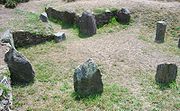
- La Hougue BieLa Hougue BieLa Hougue Bie is a historic site in the Parish of Grouville, Jersey. Hougue is a Jèrriais/Norman language word meaning a "mound" and comes from the Old Norse word haugr. Bie is of uncertain origin...
- La Pouquelaye de Faldouet
- Le Mont Ubé
- Le Couperon
- La Sergenté
- Les Mont de Grantez
- La Hougue des Géonnais
- Ville-ès-Nouaux
- The Broken Menhir
- The Ossuary
- The Little Menhir
- The Great Menhir
- La Table des Marthes
- Les Trois Rocques
- Le Pinacle
La Pouquelaye de Faldouet

Saint Martin, Jersey
-Subdivisions:St. Martin is divided into vingtaines as follows:*La Vingtaine de Rozel*La Vingtaine de Faldouet*La Vingtaine de la Quéruée*La Vingtaine de l'Église*La Vingtaine du Fief de la ReineThe Écréhous are part of the parish of St...
. It is a 5 metre long passage leading in to a large circular chamber beyond which is a large capstoned
Caprock
The Caprock is a region in the Panhandle of Texas . It is the land to the west of the Caprock Escarpment, which separates it from plains stretching to the east at a much lower elevation....
end chamber. Several smaller side chambers and cist
Cist
A cist from ) is a small stone-built coffin-like box or ossuary used to hold the bodies of the dead. Examples can be found across Europe and in the Middle East....
s form the edges of the main chamber. Human bones from at least three individuals have been recovered as well as pottery, stone axes and flint
Flint
Flint is a hard, sedimentary cryptocrystalline form of the mineral quartz, categorized as a variety of chert. It occurs chiefly as nodules and masses in sedimentary rocks, such as chalks and limestones. Inside the nodule, flint is usually dark grey, black, green, white, or brown in colour, and...
s.
Les Monts de Grantez
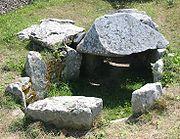
Saint Ouen, Jersey
-Cueillettes:Unlike the other parishes of Jersey, the subdivisions of this parish are not named vingtaines, but cueillettes . Vingteniers are still elected, however, in the cueillettes.*La Petite Cueillette*La Grande Cueillette...
.
It has a fine passage chamber with one side chamber to the north. The passage and side chamber retain their capstones. Excavation in 1912 located the skeletons of eight people, seven adult and one child. Seven were lying on their sides in a crouched position and the eighth in a seated position within the passage. Animal bones, pottery, shells and pebbles were also found.
Mark Patton (1987) noted that there was a considerable degree of variation in terms of funerary practices and how the dead were treated. In Mont Grantez , "seven articulated skeletons were found (six were in flexed positions in the chamber, the seventh was apparently placed in a seated position in the chamber). Disarticulated remains, however, are more usual, suggesting prior exposure or burial of the corpse."
La Sergenté
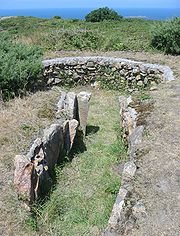
Saint Brélade, Jersey
Saint Brélade is one of the twelve parishes of the Bailiwick of Jersey. Its population is around 9,560, and it occupies the southwestern part of the island. It is the only parish to border only one other parish, St. Peter...
. It is a circular chamber with a short passage entrance. The original excavation in 1923 found a large amount of rubble within that was probably the fallen remains of a corbel
Corbel
In architecture a corbel is a piece of stone jutting out of a wall to carry any superincumbent weight. A piece of timber projecting in the same way was called a "tassel" or a "bragger". The technique of corbelling, where rows of corbels deeply keyed inside a wall support a projecting wall or...
led, bee-hive shaped vault. The style is unique to the Channel Islands
Channel Islands
The Channel Islands are an archipelago of British Crown Dependencies in the English Channel, off the French coast of Normandy. They include two separate bailiwicks: the Bailiwick of Guernsey and the Bailiwick of Jersey...
.
It is sited on open land west of Le Parcq de L'Oeillière, with a line of sight to La Table des Marthes.
Mark Patton noted that the corbelled vault required a rock such as schist, which fractures to give long, flat slabs, and in Jersey, the available rock was not suitable. Consequently, while La Sergenté is the earliest passage grave in Jersey, it collapsed soon after its construction, because of the unsuitable building materials available, and was not repeated elsewhere in the Islands."(Patton 1987a).
La Hougue des Géonnais
A neolithic passage chamber in the parish of St Ouen; it was largely ruined by quarrying prior to the initial excavation in 1929. More recent excavations (1985-1990) revealed a D shaped chamber that was extended to form an open rectangular chamber probably in Neolithic times. A vast number of finds included pottery, flint scrapers, arrowheads and broken quernsQuern-stone
Quern-stones are stone tools for hand grinding a wide variety of materials. They were used in pairs. The lower, stationary, stone is called a quern, whilst the upper, mobile, stone is called a handstone...
.
Mark Patton comments: “There are three passage graves in Jersey (Le Mont de la Ville, Faldouet and La Hougue des Géonnais) which have large, open chambers. The chambers of these monuments cannot have been roofed with capstones (the uprights are too small to have supported capstones large enough to span the chambers), and corbelled vaulting would be impractical given the character of the available stone. It is conceivable that these chambers had wooden roofs, but recent excavations at La Hougue des Géonnais provided no evidence for this. Assuming that the chambers were open, the cairns of these monuments cannot have covered the chambers whilst they were in use, and must rather have formed a sort of platform around an open ‘arena’.”
La Table des Marthes
A large flat granite slab at the western end of The Railway Walk where it meets La Rue de la Corbière. When examined in 1850 it was found to be supported at each end by pillars of stones and earth. Pottery, burnt stones and broken stone axes were found. It is unknown what kind of purpose it was used for or what kind of structure it is part of.It has been suggested that it is a huge capstone from the late Neolithic or early Bronze Age (about 2500 to 3000 BC). In historical times, it was used by the Jersey people as a place for signing contracts. Because of this it may have been allowed to stand by the side of the now disused St Helier to La Corbière railway
Jersey Railway
The Jersey Railway was opened in 1870 and was originally a standard gauge railway, long, in Jersey in the Channel Islands. Converted to narrow gauge in 1884 and extended, the line closed in 1936. It is not to be confused with the Jersey Eastern Railway....
, while so many other sites were partially destroyed for building material.
The name, which may be interpreted as La Table des Martyres and consequently translated as "The Witnesses' Table", probably derives from this known custom of signing important documents at the slab.
Le Pinacle
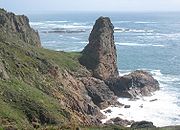
Menhir
A menhir is a large upright standing stone. Menhirs may be found singly as monoliths, or as part of a group of similar stones. Their size can vary considerably; but their shape is generally uneven and squared, often tapering towards the top...
. Two earth and rubble ramparts have been attributed to the Neolithic/Chalcolithic periods and a third to the Bronze Age
Bronze Age
The Bronze Age is a period characterized by the use of copper and its alloy bronze as the chief hard materials in the manufacture of some implements and weapons. Chronologically, it stands between the Stone Age and Iron Age...
. Six pieces of iron found at the site have been attributed to Iron Age
Iron Age
The Iron Age is the archaeological period generally occurring after the Bronze Age, marked by the prevalent use of iron. The early period of the age is characterized by the widespread use of iron or steel. The adoption of such material coincided with other changes in society, including differing...
occupation. In Roman times a rectangular Gallo-Roman temple was constructed. Amongst the large number of finds from various excavations are flints, hammers, rubbers, polishing stones, a copper arrow head, bronze spear head, wheel turned pottery and a Roman coin.
It is sited on the west of Le Chemin des Landes. The path down to the site is treacherous, and has in recent times seen two tragic deaths. It is inadvisable to go down unless with properly qualified climbers.
Mark Patton comments: “Recent research has demonstrated the existence of an axe production centre at Le Pinacle, Jersey, and ‘Type P’ dolerite axes produced at Le Pinacle have been identified in assemblages from Guernsey, Sark and Alderney as well as Jersey. Axes of Type P dolerite, however, seem not to be found on the Armorica
Armorica
Armorica or Aremorica is the name given in ancient times to the part of Gaul that includes the Brittany peninsula and the territory between the Seine and Loire rivers, extending inland to an indeterminate point and down the Atlantic coast...
n mainland. “
La Hougue Boëte
This is a high oval mound in in the Parish of St JohnSaint John, Jersey
Saint John is one of the twelve parishes of Jersey in the Channel Islands.-Geography:Saint John is in the north of Jersey and borders St Mary on its west, Trinity to the east, and St Lawrence and Saint Helier on its south....
. Here a four sided Neolithic chamber was found when tunnelled into by excavators in 1911. The cist was found to contain an unusual burial, that of a man lying on top of a horse. Other reported finds included a round bottomed vessel and fragment of a greenstone
Greenstone (archaeology)
Greenstone is a common generic term for valuable, green-hued minerals and metamorphosed igneous rocks and stones, that were used in the fashioning of hardstone carvings such as jewelry, statuettes, ritual tools, and various other artefacts in early cultures...
axe. The horses bones were carbon dated to the Celtic period. It seems likely that the site was built in Neolithic times then re-used in Celtic times for a chieftain’s burial.
This is the only known megalithic cist with round mound of its type in the Channel Islands and may be culturally linked to early Neolithic cists in south Brittany. The site is also of interest as the location of a seigniorial court.
The Duke of Normandy
Duke of Normandy
The Duke of Normandy is the title of the reigning monarch of the British Crown Dependancies of the Bailiwick of Guernsey and the Bailiwick of Jersey. The title traces its roots to the Duchy of Normandy . Whether the reigning sovereign is a male or female, they are always titled as the "Duke of...
granted lands here in Jersey to his favoured subjects. They became Seigneur of a fief, often living in a manor house, centrally placed in the area. Anyone living in a fief became a 'tenant' paying rent to the church (usually a tenth of their grain crops) and working for an agreed number of days on the Seigneur's land. The system worked well because tenants had the use of the Seigneurial mill, saving them many hours of work, and disputes between tenants were settled by the Seigneurial court. Incidentally, the Seigneur did not preside over the court most of the time, but left it to deputies, or “prévôts”.
Originally every Seigneurial Court had its Prévôt. appointed annually on some Fiefs by the Seigneur, on others by the Tenants, "to guard the rights of the Seigneur and the tenants, to make good all summonses and loyal records, and to pay the corn-rentes, fermes, and extracts". He had to enforce all orders of the Court and all bye-laws of the Fief.
Mont Ubé
This is a Neolithic passage grave in Parish of St Clement.When it was discovered it 1848, the capstones were blasted and removed by quarrymen for building materials. Inside were found human bones, urns, axes and a polished stone pendant. The local farmer who was responsible for the blasting then used the remaining upright stones as a pig until it was reclaimed as a historic site.
Le Couperon
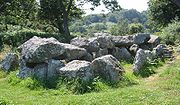
When found in 1868, this was a long chamber surrounded by a ring of eighteen outer stones, which had been originally covered by a long mound. Unfortunately in the stones were scattered when the mound was dug up by the farmer, so that what we see today is largely the work of restorers in 1919. The "U" shaped stone at one end is thought to have been originally separating two parts of the chamber. Finds included a few flint flakes and pottery fragments.
Archaeological ages table
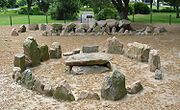
| La Sergenté | 4500 BC, Early Neolithic |
| Le Pinacle | 4500- Early Neolithic to Roman |
| La Hougue Bie, Passage Grave | 4000-3200 BC, Neolithic |
| La Cotte de St Brelade | 100,000-40,000 Paleolithic to Mesolithic |
| Mont Ubé, Passage Grave | 4000-3200 BC, Neolithic |
| Mont Grantez, Passage Grave | 4000-3200 BC, Neolithic |
| Faldouet, Passage Grave | 4000-3200 BC, Neolithic |
| Le Couperon, Gallery Grave | 3000 BC, Late Neolithic |
| Ville ès Nouaux, Gallery Grave | 3250-2850 BC, Late Neolithic |
| Menhirs | 3000-1500 BC, Late Neolithic |
| Ville ès Nouaux, Cist in Circle | 2800-2000 BC, Late Neolithic |
Beaker People or Culture?
When Jacquetta HawkesJacquetta Hawkes
Jacquetta Hawkes was a British archaeologist.Born Jessie Jacquetta Hopkins, the daughter of Nobel Prize-winning scientist, Sir Frederick Gowland Hopkins, she married first Christopher Hawkes, then an Assistant Keeper at the British Museum, in 1933. From 1953, she was married to J. B. Priestley...
wrote "The Archaeology of the Channel Islands", she mentioned "the Beaker people" who spread across Europe, possibly from the Iberian peninsula
Iberian Peninsula
The Iberian Peninsula , sometimes called Iberia, is located in the extreme southwest of Europe and includes the modern-day sovereign states of Spain, Portugal and Andorra, as well as the British Overseas Territory of Gibraltar...
. They were defined by a distinctive pottery style - a beaker with a distinctive bell-shaped profile - that spreads across the Western continent around 2000 B.C. Burial customs of the Beaker people included placing their dead in round barrows, often with a beaker, perhaps to hold a drink for the dead on their final journey. Evidence of such beakers and artefacts have been found in Jersey at Ville ès Nouaux.
The existence of the migratory "Beaker people" is still very much the popular position. Richard R. Doornek writing in the magazine "School Arts" in 1989 on Stonehenge
Stonehenge
Stonehenge is a prehistoric monument located in the English county of Wiltshire, about west of Amesbury and north of Salisbury. One of the most famous sites in the world, Stonehenge is composed of a circular setting of large standing stones set within earthworks...
mentions that about 2100 BC, "the Beaker people, named after their highly sophisticated pottery, arrived in Britain from the Continent through the Low Countries. Geoffrey Humphrys also writes on Stonehenge in the magazine "Contemporary Review" (1994), and again we hear that "about 2100 BC, the Beaker people are reckoned to have started erecting two circles of bluestones".
But many historians and archaeologists now believe that the Beaker people did not exist as a group; as Mark Patton explains, the beakers and related artefacts that are attributed to the Beaker people may well indicate the migration of a "beaker culture" rather than a "beaker people". This is most succinctly summed up by Ronald Hutton:
"One of the major developments in British archaeology during the past twenty years has been the loss of confidence by its practitioners in their ability to recognise the movement of peoples. The problem is that an existing population can adopt foreign artefacts and fashions so completely as to appear to have been replaced by foreigners. Thus, according to traditional archaeological practice, had modern Britain been an illiterate society then it would have been natural to have spoken of the invasion of the 'Washing Machine People' in the 1950s and large-scale Japanese immigration in the 1970s."
The recent discovery of the burial of the "Amesbury Archer
Amesbury Archer
The Amesbury Archer is an early Bronze Age man whose grave was discovered during excavations at the site of a new housing development in Amesbury near Stonehenge. The grave was uncovered in May 2002, and the man is believed to date from about 2300 BC. He is nicknamed the "archer" because of the...
" in Wiltshire, however, has brought the idea of a "Beaker people" to the fore again. This individual was clearly a high status male, buried with copper tools and gold jewellery as well as beakers, and oxygen isotope analysis on his teeth indicates that he grew up in central Europe, possibly Switzerland or Austria. Immigration clearly happened, but not necessarily on a large scale: the arrival of a small number of immigrants, bringing with them new technologies, skills and ideas, may have provoked a profound change in the nature of society.

